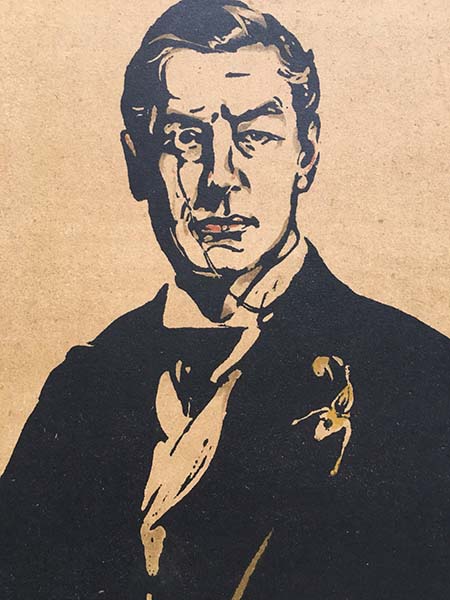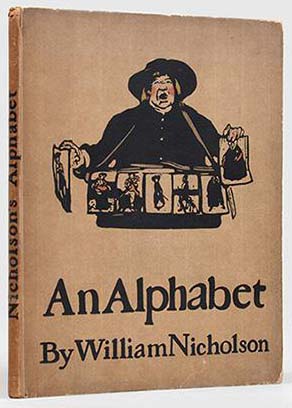Share via:
Sir William Nicholson – British artist, illustrator, and author, 1872-1949

William Nicholson’s relatively small body of work made a tremendous impact on the development of the picture book as a significant literary form. He wrote as well as illustrated only two of his own picture books, Clever Bill (1926) and The Pirate Twins (1929). These works, published between the two world wars during a productive and creative period in children’s literature, inspired such innovative illustrators as the American fine artist Wanda Gag and renowned author-illustrator Maurice Sendak. Today, Nicholson is best known for his woodcut illustrations for Margery Williams’s classic story The Velveteen Rabbit (1922).
At the end of the nineteenth century, Nicholson published his first book, An Alphabet (1898), using a genre known to serve aspiring artists and writers as a “peg to hang pictures and rhymes on.” Two years later, he illustrated Arthur Waugh’s rhyming text The Square Book of Animals (1900). Nicholson’s bold, graphic style, no doubt influenced by his background in poster making, heralded a new look in children’s books. In addition to book illustration, poster making, and portrait painting, Nicholson was involved with the theater. During the early twenties, he designed the costumes and sets for J. M. Barrie’s Peter Pan.

First published in England, Clever Bill served as a prototype for the modern American picture book. Published in the United States in 1927, the book featured an oblong format, rarely before seen in children’s picture books, that enhanced the overall design while facilitating the quick pace of the story.
Nicholson’s spare text, hand-lettered in his own script and paired with the simply rendered but detailed woodcut illustrations, races along from the very first page. By using an incomplete sentence—“One day the Postman; brought Mary a letter from her—” Nicholson lures the reader into turning the page, an innovative stylistic technique later employed by other great picture-book authors such as Marjorie Flack in her “Angus” books. Drama and tension build as Mary tries to pack her favorite belongings into her green suitcase.
Of course. Clever Bill gets left behind, but not for long; he chases the tram and surprises Mary with a welcoming salute at the train station in Dover. William Nicholson’s use of line adds levity and action to the pictures, enhancing the story’s lively spirit of adventure. He unified art and text by using the same bold lines in both his drawings and the hand-lettered words that tell the story. Even the book cover and end papers are similarly decorated. Maurice Sendak, one among the many contemporary illustrators who have admired and learned from William Nicholsons work, has written, “Clever Bill, I have long felt, is among the few perfect picture books ever created for children.”
§ S.M.G.
Source: Children’s Books and their Creators, Anita Silvey.
Sir William Nicholson Works
As author and illustrator
- An Alphabet. London: William Heinemann, 1898.
- Twelve Portraits. London: William Heinemann; [New York]: R.H. R[ussell], 1899.
- Douze portraits Paris: H. Floury, [1899].
- Characters of Romance. London: William Heinemann, New York: R.H. Russell, 1900.
- Twelve Portraits – Second Series. London: William Heinemann; New York: R.H. Russell, 1902.
- Clever Bill. [London]: William Heinemann, [1926].
- The Pirate Twins. [London]: Faber & Faber, [1929].
- The Book of Blokes. [London]: Faber & Faber, [1929].
As Illustratror
- An Almanac of Twelve Sports. Verses by Rudyard Kipling, illustrations by William Nicholson. London: William Heinemann, 1897.
- Almanach de douze sports 1898. Illustrations by William Nicholson, text by Octave Uzanne (Kipling’s verses were not used in the French edition). Paris: Société française d’éditions d’art, [1898].
- London Types. Quatorzains by William Ernest Henley, illustrations by William Nicholson. London: William Heinemann; New York: R.H. Russell, 1898.
- Tony Drum: a Cockney Boy. Edwin Pugh, ten coloured plates from designs by the Beggarstaff Brothers (five by Nicholson, five by James Pryde). London: William Heinemann; New York: Henry Holt and Company, 1898.
- The Square Book of Animals. Rhymes by Arthur Waugh, illustrations by William Nicholson. London: William Heinemann, 1900 (designed 1896, copyright 1899).
- Oxford, Parts I and II, each containing lithographs by William Nicholson, descriptive notes by Arthur Waugh. London: Stafford Gallery, 1905.
- The Velveteen Rabbit, or, How Toys Became Real. Margery Williams, illustrations by William Nicholson. London: William Heinemann, 1922.
